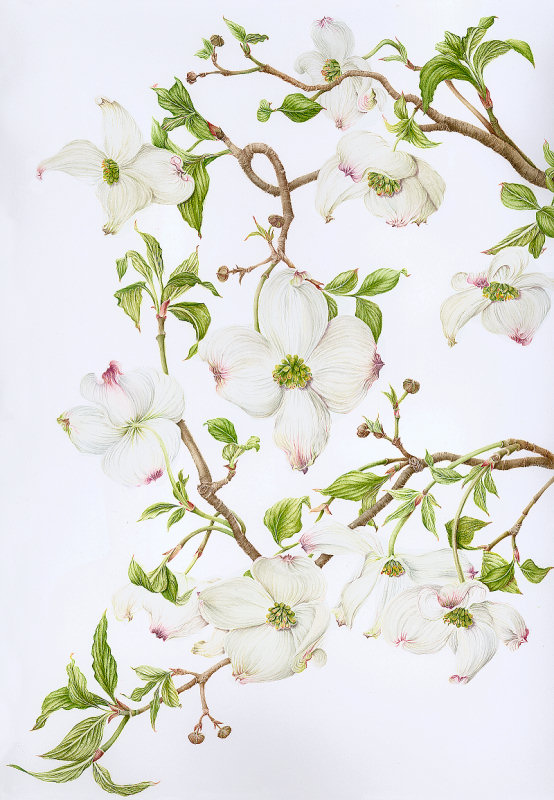2008

Its name derives from the Latin corneus, meaning horn, for its hard, strong and shock resistant wood; and florida for its floral abundance early in the spring.
Four large greenish-white bracts, neither petals or sepals but “tepals” notched with deep burgundy at the apex, surround a cluster of approximately 20 tiny inconspicuous flowers. Each of these has four yellowish green petals and vermillion stamens making up an umbel-shaped inflorescence. The flowers are bisexual.
According to folklore Christ was nailed to a cross made of Dogwood. Sensing the tree’s regret, he decreed that never again would dogwoods be large enough to serve for crucifixion; its flowers would represent the cross with 2 bracts longer and 2 smaller ones; the deep red tips would remind us of blood-stains where nails had pierced his flesh; a crown-of-thorns rested in the center.
So much for legend. It is in temperate zones that the flowering dogwood found and is a favorite ornamental species with a burst of white in the spring and a dramatic transformation in the autumn when its leaves and fruit aquire glints of ruby and garnet. Birds and mammals feast on its foliage and fruit which is high in fat and calcium.
Humans have valued its hard, heavy, fine-grained wood, close-textured, smooth and capable of withstanding rough use. ‘Dags’ (daggers, skewers) were made from its timber, hence it is thought that dogwood comes from dagwood. Shuttles and spindles, tool handles and small pulleys, golf clubs and roller-skate wheels, knitting needles and spools, malletheads, jewelers’ blocks, and turnpins rely on the resistance and durability of the Dogwood. Native tribes in the past made use of the tree for infusions and poultices to treat a host of maladies; twigs, stripped of bark, whitened teeth; extracts from berries and bark yielded dyes and inks.
The flowering of the Dogwood in the third week of May signalled the time of corn-planting for Native peoples and the arrival of a new season, as it still does today.
The Case of the Purloined Painting
Move forward to Thanksgiving weekend, 2013. Best friend’s husband finds it’s for sale on Craigslist. He advises against my impulse to race over to rescue the painting. “It’s a legit business called Modern Artifacts. They’ve even provided a link to your website. They’re clearly not doing anything shady.” I hadn’t called the police when the painting disappeared and legal advice was unaffordable. “The police would know what to do,” Toby insists.
It’s now Saturday morning of Thanksgiving weekend and the dispatcher says an officer will contact me. Within minutes a police car pulls up and a tall, imposing officer stands in the doorway. He listens attentively to my account, scans Toby’s email messages, the Craigslist entry with photo, my website, and the website of the antique dealer. He hands me his IPD card, writing down also a case number and his cell number. “Don’t worry, I’ll take care of this.”
Indeed! Within an hour and a half, officer Greg Firman is back in person. He’s seen the painting hanging in a booth at the barn, together with what he calls “assorted high end garage sale items.” He mentioned the lost art work to the owners, Bill and Kristin, and inquired into its provenance. Assured after close questioning that they had acquired it honestly, he informed them that it had gone missing for five years and should be returned to its rightful owner. At once they said they would be “honored” to do so.
Officer Firman hands me their business card and assures me they have a clean record, sound like honest, decent people and I should call them right away. He claims to know nothing about art but seems enlivened by this case, and wonders if the adventures of the Dogwood might perchance enhance its value? He wishes me a very happy holiday and adds, “If all calls to the IPD had such satisfactory conclusions wouldn’t it be great?” Impulsively I give him a big hug, but my arms aren’t long enough to encircle all the accoutrements of the uniform. Have you ever tried hugging a uniformed police officer?
Bill and Kristin soon arrive at my place with their little daughter and the Dogwood. I beg for a blow-by-blow account of their acquisition and learn they found it at a local garage sale, recognized at once that it was an original watercolor in pristine condition, but were unable to decipher the signature. So having paid an exorbitant $20, they googled local botanical illustrators and discovered my website with the painting. They were thrilled. “We’re treasure seekers,” they tell me, “and we knew we’d found one.”
We spend an hour in excited talk. Their livelihood, they say, is discovering treasures people have discarded, and the likely return on their investment this time has been the greatest ever in their wanderings through garage, estate and sales—over a hundred times. But now they have the rare chance to restore a lost painting to its creator, and the satisfaction of that is beyond profit, they claim.
Over their objections, I absolutely insist on refunding their $20—for my own sake, for the emotional value of this closed circle. We part in mutual exhilaration. In just fifteen hours—anxious, yes, but hopeful hours—the painting, after a five-year abduction, is recovered.